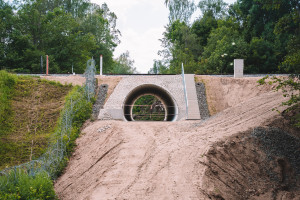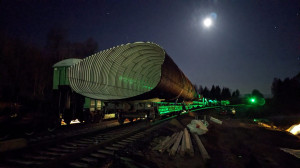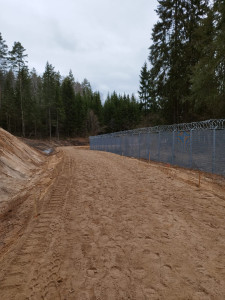








 copy.jpg)
Increasing the efficiency of state border security by ensuring appropriate border guarding conditions is considered to be the protection of national security interests, preventing a possible threat to the state, namely, an uncontrolled increase in the flow of migrants to the state border between the Republic of Latvia and Belarus. In order to ensure an effective border security function, as provided for in the Law on the Development of the Infrastructure for the Construction of the External Land Border and its annotation, it is necessary to build an appropriate infrastructure. It is planned to build a high security fence, patrol paths, patrol footbridges, a tunnel for crossing railway tracks, etc. Taking into account the readiness of the land plots for construction works, the initial priority corresponds to the planned deforestation works of JSC "Latvijas valsts meži" - 83.9 km long. Whereas the scope of the works of the second stage covers 63.9 km, thus encompassing the entire Republic of Latvia – Republic of Belarus land section.
In order to allow the safe movement of animals, a study was carried out, as a result of which a map of animal movement routes and a solution for animal crossings was developed by LVMZI "Silava." This is an essential precondition for the development of a construction project and the coordination of a construction project.
Construction plan solutions will be adapted to each specific area and actual natural conditions - swamps, cliffs, flooded areas, lake crossings. It is important to adapt infrastructure so that it is both sustainable and economically viable. The construction plan documentation is expected to be developed by June 2022 (except for the tunnel solution, which will be developed by September 2022).
Building border infrastructure is of vital importance. The fence itself offers a physical barrier preventing hundreds of people from quickly entering Latvia through a single location. The infrastructure built so far makes it possible for us to quickly move along the border, improving our response times if there is a violation. We can use quads and buggies to move along the fence, for more rapid detection of locations where violations have occurred. Pontoon trails and boardwalks in swamps mean that border guards no longer have to make kilometres-long detours to get to the other side of a lake or a marshy area. The tunnel under the railway tracks enables us to quickly cross the railway line.
Guntis Pujāts,
Head of the State Border Guard





















-thumbnail.jpg)
